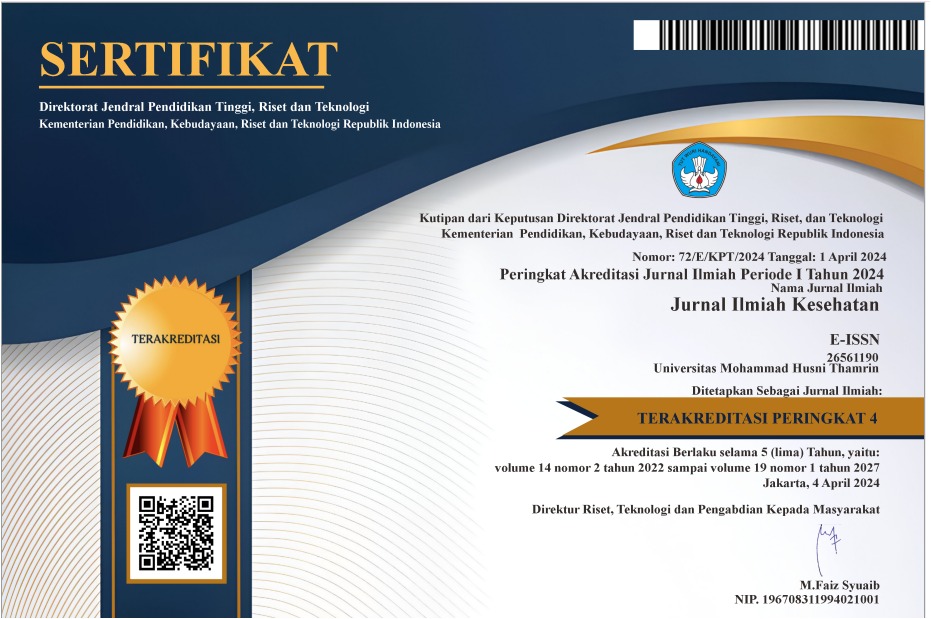The Relationship Between Anxiety Levels and Premenstrual Syndrome (PMS) Among Female Adolescents at Mulia Karya Husada Health Vocational School
Hubungan Tingkat Kecemasan Dengan Premenstrual Syndrome (Pms) Pada Remaja Puteri Di Smk Kesehatan Mulia Karya Husada
DOI:
https://doi.org/10.37012/jik.v17i2.2939Keywords:
Premenstrual Syndrome, PMS, Female Adolescents, AnxietyAbstract
Adolescence is an important phase in the physical, psychological, and social development of individuals. Female adolescents experience significant hormonal changes, particularly related to the menstrual cycle, which often causes both physical and psychological discomfort. One of the common problems faced is Premenstrual Syndrome (PMS), which is characterized by various physical and psychological symptoms such as mood swings, anxiety, depression, fatigue, breast tenderness, bloating, and changes in sleep patterns that affect different aspects of life. Anxiety experienced by adolescents during PMS is often overlooked, yet it can significantly affect their quality of life if there is no effective intervention to reduce its negative impacts. The aim of this study is to determine the relationship between anxiety levels and Premenstrual Syndrome (PMS) among female adolescents at Mulia Karya Husada Health Vocational School. This study employed a cross-sectional design. The research sample consisted of 153 female adolescents at Mulia Karya Husada Health Vocational School. Data were collected using questionnaires. The results showed that the majority of respondents experienced mild anxiety (141 students, 92%) and the majority did not experience Premenstrual Syndrome (130 students, 85%). The analysis using the chi-square test revealed a significant relationship between anxiety levels and the occurrence of Premenstrual Syndrome (PMS) with a p-value = 0.00; p < 0.05. The Prevalence Ratio (PR) was 1.6 (95% CI: 1.0–2.6), indicating that respondents with severe anxiety had a 1.6 times higher risk of experiencing PMS compared to those with mild anxiety. The study recommends the need for educational efforts to prevent the further impact of anxiety levels among female adolescents during PMS.
References
American College of Obstetricians and Gynecologists (ACOG). (2023). Management of Premenstrual Disorders: ACOG Clinical Practice Guideline, Number 7. Obstetrics & Gynecology, 142(4), 993–1011. https://doi.org/10.1097/AOG.0000000000005370
Farrokh-Eslamlou, H., Oshnouei, S., &Heshmatian, B. (2021). Premenstrual Syndrome and Related Factors among Iranian Female Adolescents. Journal of Pediatric and Adolescent Gynecology, 34(2), 190-194. https://doi.org/10.1016/j.jpag.2020.11.007
Frontiers in Psychiatry. (2024). Premenstrual syndrome: New insights into etiology and review of current treatment approaches. Frontiers in Psychiatry, 15, 1363875. https://doi.org/10.3389/fpsyt.2024.1363875
Jafari, M., Ghasemi, M., &Salari, R. (2021). Relationship Between Premenstrual Syndrome and Anxiety in Adolescents: A Cross-sectional Study. Journal of Psychosomatic Obstetrics & Gynecology, 42(1), 22-28. https://doi.org/10.1080/0167482X.2020.1772911
Ju, H., Jones, M., &Mishra, G. (2014). Premenstrual Syndrome and Premenstrual Dysphoric Disorder in Young AdultWomen: A Cross-sectional Study. European Journal of Obstetrics & Gynecology and Reproductive Biology, 179, 145-149. https://doi.org/10.1016/j.ejogrb.2014.05.017
Kemenkes RI. (2022). Penyuluhan kesehatan remaja: Premenstrual syndrome (PMS). Jakarta: Direktorat Kesehatan Reproduksi, Kemenkes RI.
Kiesner, J. (2020). A Longitudinal Investigation of Premenstrual Symptoms in Adolescents: The Impact of Stress and Hormones. Hormones and Behavior, 126, 104872. https://doi.org/10.1016/j.yhbeh.2020.104872
Pomeroy, C. (2001). Anxiety and Premenstrual Syndrome: Implications for Treatment and Management. Journal of Women's Health, 10(4), 389-397. https://doi.org/10.1089/152460901750269646
Stuart, G. W. (2016). Principles and Practice of Psychiatric Nursing (10th ed.). St. Louis: Elsevie
Sadock, B. J., Sadock, V. A., & Ruiz, P. (2017). Kaplan & Sadock’s Synopsis of Psychiatry: Behavioral Sciences/Clinical Psychiatry (11th ed.). Philadelphia: Wolters Kluwer.
Sudayana. (2025). Hubungan tingkat kecemasan dengan premenstrual syndrome (PMS) pada mahasiswi kedokteran umum Universitas Islam Sultan Agung Semarang. Universitas Islam Sultan Agung Semarang.
World Health Organization (WHO). (2022). Anxiety Disorders. Retrieved from https://www.who.int
World Health Organization. (2020). Adolescent Development. Diakses dari https://www.who.int
Yonkers, K. A., O'Brien, P. M. S., &Eriksson, E. (2020). Premenstrual Syndrome. Lancet, 392(10152), 2223-2234.
Yunitasari. (2023). Pengaruh kecemasan terhadap keseimbangan hormon estrogen dan progesteron yang memperburuk gejala PMS pada mahasiswi STIKes Hutama Abdi Husada. STIKes Hutama Abdi Husada
Downloads
Published
How to Cite
Issue
Section
Citation Check
License
Copyright (c) 2025 Dwinara Febrianti, Lia Fitriyanti, Helena Golang Nuhan

This work is licensed under a Creative Commons Attribution 4.0 International License.
Jurnal Ilmiah Kesehatan allows readers to read, download, copy, distribute, print, search, or link to the full texts of its articles and allow readers to use them for any other lawful purpose. The journal allows the author(s) to hold the copyright without restrictions. Finally, the journal allows the author(s) to retain publishing rights without restrictions Authors are allowed to archive their submitted article in an open access repository Authors are allowed to archive the final published article in an open access repository with an acknowledgment of its initial publication in this journal.

Lisensi Creative Commons Atribusi 4.0 Internasional.










